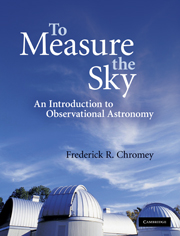4 - Names, catalogs, and databases
Published online by Cambridge University Press: 05 June 2012
Summary
…the descriptions which we have applied to the individual stars as parts of the constellation are not in every case the same as those of our predecessors (just as their descriptions differ from their predecessors')…However, one has a ready means of identifying those stars which are described differently; this can be done simply by comparing the recorded positions.
Claudius Ptolemy, c. AD 150, The Almagest, Book VII, H37You can discover traces of the history of astronomy scattered in the names of the objects astronomers discuss – a history that starts with the mythological interpretation of the sky echoed in constellation names, and that continues to an era when comets are named after spacecraft and quasars after radio telescopes. As discoveries accumulate, so too do the names. As the number of objects of interest has risen to the hundreds of millions, tracking their identities and aliases has grown to a daunting enterprise, made tractable only by the use of worldwide computer networks and meta-database software. In this chapter we introduce the methods for identifying a particular celestial object, but more importantly, the methods for discovering what is known about it.
Very early in the history of astronomy, as Ptolemy tells us, astronomers realized the obvious. The identities of most objects in the sky, like the identities of mountains or cities, could be safely tied to their locations. However, a difficult problem arises in our Solar System (the subject of most of The Almagest), where objects move around the sky quickly.
Information
- Type
- Chapter
- Information
- To Measure the SkyAn Introduction to Observational Astronomy, pp. 98 - 117Publisher: Cambridge University PressPrint publication year: 2010
